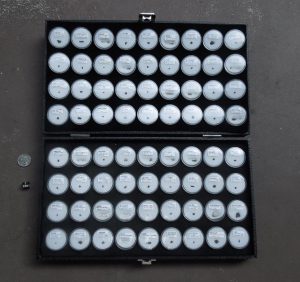
While we look into the skies, viewing the heavens through the optical wonders telescopes have evolved into today, we often forget that these cosmic phenomena sometimes drop right into our laps, at least from a galactic perspective. As meteorites pepper the earth on a daily basis, we continue to experience new and exciting things to hold and behold.
A case in point is a rare meteorite that fell earlier this year in Costa Rica. Galactic Stone & Ironwork is owned and operated by a veteran collector of meteorites and was able to curate a collection of pieces of this meteorite to make available to his customers.
Galactic Stone also offers micromounts, which offer small, sample-sized meteorite specimens. These micromounts offer the opportunity to purchase as single specimen or collection kits with over 70 specimens (Image 1).
Take, for example, a lot of six meteorite micromounts currently available as a package (Image 2). All six specimens are of the H.E.D.O. (HED) class of Vestan meteorites. The so-called “HEDO” group consists of several related achondrites which originate from the same asteroid – 4 Vesta. As one of the largest bodies in the main asteroid belt, Vesta is one of the few asteroids visible to naked eye on Earth under the right conditions. Vesta is a failed planet that started to settle into layers. The different types of HEDO meteorites represent the different layers of Vesta’s geology.

Howardite meteorites represent the top-soil layer of Vesta – the fine regolith dust and fragments that cover the surface of the asteroid. This regolith often contains remnants of foreign impactors that have struck the surface of Vesta over time.
Eucrite meteorites represent a magmatic type of upper mantle material that is the bedrock that the upper regolith sits upon. Most of the eucritic material on Vesta is under the surface, but some has been exposed by impacts.
Diogenite meteorites represent the deeper mantle material that is underneath the eucrite layer. It is usually more altered, oxidized, and compacted than the eucrite and howardite material above it. Like eucrites, most diogenite material resides deep under the current surface of Vesta, but some has been exposed or ejected by impact events.
Olivine Diogenite meteorites represent the deepest mantle material currently known to science. This odd material is mostly crystalline in nature and is the result of extreme heat and pressure.
In the lot of micromounts, you get the following meteorites from Vesta :
1) NWA 2060 (Howardite, found in the Sahara in 2003)
2) Millbillillie (Eucrite, monomict, witnessed fall from Australia 1960)
3) Tirhert (Eucrite, unbrecciated, witnessed fall from Morocco 2014)
4) NWA 4755 (Diogenite, found in the Sahara in 2006)
5) Tatahouine (Diogenite, witnessed fall from Tunisia in 1931)
6) NWA 1877 (Olivine Diogenite, found in the Sahara in 2003)
This collection is priced at only $29.00. And there is so much more on the Galactic Stone website to enjoy and collect. Feel free to check them out for yourself!

